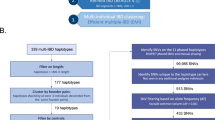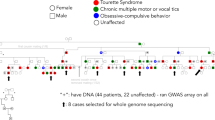Abstract
The dopamine transporter gene (DAT) has been implicated in a variety of disorders, including bipolar disorder, attention-deficit hyperactivity disorder, cocaine-induced paranoia, Tourette's syndrome, and Parkinson's disease. As no clear functional polymorphism has been identified to date, studies rely on linkage disequilibrium (LD) to assess the possible genetic contribution of DAT to the various disorders. A better understanding of the complex structure of LD across the gene is thus critical for an accurate interpretation of the results of such studies, and may facilitate the mapping of the actual functional variants. In the process of characterizing the extent of variation within the DAT gene, we have identified a number of single nucleotide polymorphisms (SNPs) suitable for LD studies, 14 of which have been analyzed, along with a 3′ repeat polymorphism, in a sample of 120 parent-proband triads. Calculations of pairwise LD between the SNPs in the parental haplotypes revealed a high degree of LD (P < 0.00001) in the 5′ (distal promoter through intron 6) and 3′ (exon 9 through exon 15) regions of DAT. This segmental LD pattern is maintained over approximately 27 kb and 20 kb in these two regions, respectively, with very little significant LD between them, possibly due to the presence of a recombination hotspot located near the middle of the gene. These analyses of the DAT gene thus reveal a complex structure resulting from both recombination and mutation, knowledge of which may be invaluable to the design of future studies.
This is a preview of subscription content, access via your institution
Access options
Subscribe to this journal
Receive 12 print issues and online access
$259.00 per year
only $21.58 per issue
Buy this article
- Purchase on Springer Link
- Instant access to full article PDF
Prices may be subject to local taxes which are calculated during checkout





Similar content being viewed by others
References
Giros B, Caron MG . Molecular characterization of the dopamine transporter Trends in Pharmacol Sci 1993 14: 43–49
Ritz MC, Lamb RJ, Goldberg SR, Kukor MJ . Cocaine receptors on dopamine transporters are related to self-administration of cocaine Science 1987 237: 1219–1223
Kitayama S, Wang J-B, Uhl GR . Dopamine transporter mutants selectively enhance MPP+ transport Synapse 1993 15: 58–62
Giros B, el Mestikawy S, Godinot N, Zheng K, Han H, Yang-Feng T et al. Cloning, pharmacological characterization, and chromosome assignment of the human dopamine transporter Mol Pharmacol 1992 42: 383–390
Vandenbergh DJ, Thompson MD, Cook EH, Bendahhou E, Nguyen T, Krasowski MD et al. Human dopamine transporter gene: coding region conservation among normal, Tourette's disorder, alcohol dependence and attention-deficit hyperactivity disorder populations Mol Psychiatry 2000 5: 283–292
Kelsoe JR, Sadovnick AD, Kristbjarnarson H, Bergesch P, Mroczkowski-Parker Z, Drennan M et al. Possible locus for bipolar disorder near the dopamine transporter on chromosome 5 Am J Med Genet (Neuropsychiat Genet) 1996 67: 533–540
Cook EH, Stein MA, Krasowski MD, Cox NJ, Olkon DM, Kieffer JE et al. Association of attention-deficit disorder and the dopamine transporter gene Am J Hum Genet 1995 56: 993–998
Waldman ID, Rowe DC, Abramowitz A, Kozel ST, Mohr JH, Sherman SL et al. Association and linkage of the dopamine transporter gene and attention-deficit hyperactivity disorder in children: heterogeneity owing to diagnostic subtype and severity Am J Hum Genet 1998 63: 1767–1776
Persico AM, Macciardi F . Genotypic association between dopamine transporter gene polymorphisms and schizophrenia Am J Med Genet (Neuropsychiatr Genet) 1997 74: 53–57
Gelernter J, Kranzler HR, Satel SL, Rao PA . Genetic association between dopamine transporter protein alleles and cocaine-induced paranoia Neuropsychopharmacology 1994 11: 195–200
Muramatsu T, Higuchi S . Dopamine transporter gene polymorphism and alcoholism Biochem Biophys Res Commun 1995 211: 28–32
Sander T, Harms H, Podschus J, Finckh U, Nickel B, Rolfs A et al. Allelic association of dopamine transporter gene polymorphism in alcohol dependence with withdrawal seizures or delirium Biol Psychiatry 1997 41: 299–304
Schmidt LG, Harms H, Kuhn S, Rommelspacher H, Sander T . Modification of alcohol withdrawal by the A9 allele of the dopamine transporter gene Am J Psychiatry 1998 155: 474–478
Higuchi S, Muramatsu T, Arai H, Hayashida M, Sasaki H, Trojanowski JQ . Polymorphisms of dopamine receptor and transporter genes and Parkinson's disease J Neural Transm 1995 10: 107–113
Le Couteur DG, Leighton PW, McCann SJ, Pond SM . Association of a polymorphism in the dopamine transporter gene with Parkinson's disease Mov Disord 1997 12: 760–763
Heinz A, Goldman D, Jones DW, Palmour R, Hommer D, Gorey JG et al. Genotype influences in vivo dopamine transporter availability in human striatum Neuropsychopharmacology 2000 22: 133–139
Hartl DL, Clark AG . Principles of Population Genetics Sinauer Associates: Massachusetts 1990
Grunehage F, Schulze TG, Muller DJ, Lanczik M, Franzek E, Albus M et al. Systematic screening for DNA sequence variation in the coding region of the human dopamine transporter gene (DAT1) Mol Psychiatry 2000 5: 275–282
Greenwood TA, Alexander M, Keck PE, McElroy S, Sadovnick AD, Remick RA et al. Evidence for linkage disequilibrium between the dopamine transporter and bipolar disorder Am J Med Genet (Neuropsychiatr Genet) 2001 105: 145–151
Vandenbergh DJ, Persico AM, Uhl GR . A human dopamine transporter cDNA predicts reduced glycosylation, displays a novel repetitive element and provides racially-dimorphic TaqI RFLPs Mol Brain Res 1992 15: 161–166
Don RH, Cox PT, Wainwright BJ, Baker K, Matick JS . ‘Touchdown’ PCR to circumvent spurious priming during gene amplification Nucleic Acids Res 1991 19: 4008
Lewontin RC . On measures of gametic disequilibrium Genetics 1988 120: 849–852
Abecasis GR, Cookson WO . GOLD – Graphical overview of linkage disequilibrium Bioinformatics 2000 16: 182–183
Swofford DL . PAUP.* Phylogenetic Analysis Using Parsimony(* and Other Methods). Version 4.0 Sinauer Associates: Massachusetts 1998
Hudson RR, Kaplan NL . Statistical properties of the number of recombination events in the history of a sample of DNA sequences Genetics 1985 111: 147–164
Kouzmenko AP, Pereira A, Singh BS . Intronic sequences are involved in neural targeting of human dopamine transporter gene expression Biochem Biophys Res Comm 1997 240: 807–811
Byerley W, Hoff M, Holik J, Caron MG, Giros B . VNTR polymorphism for the human dopamine transporter gene (DAT1) Hum Mol Genet 1993 2: 335
Clark AG, Weiss KM, Nickerson DA, Taylor SL, Buchanan A, Stengard J et al. Haplotype structure and population genetic inferences from the nucleotide sequence variation in human lipoprotein lipase Am J Hum Genet 1998 63: 595–612
Bonnen PE, Story MD, Ashorn CL, Buchholz TA, Weil MM, Nelson DL . Haplotypes at ATM identify coding-sequence variation and indicate a region of extensive linkage disequilibrium Am J Hum Genet 2000 67: 1437–1451
Acknowledgements
We would like to thank the family members who participated in this study, without whom this work would not be possible. This work was supported by Novartis Pharma AG and grants to JRK from the Department of Veterans Affairs and the NIMH (MH47612, MH59567). Support was also provided by the UCSD Mental Health Clinical Research Center (MH30914) and the UCSD General Clinical Research Center (M01 RR00827). TAG was supported by training grants to the UCSD Biomedical Sciences and Genetics graduate programs (5T32CA67754, 1T32GM08666). Data and biomaterials were collected in four projects that participated in the National Institute of Mental Health (NIMH) Bipolar Disorder Genetics Initiative. From 1991–98, the Principal Investigators and Co-Investigators were: Indiana University, Indianapolis, IN, UO1 MH46282, John Nurnberger, MD, PhD, Marvin Miller, MD, and Elizabeth Bowman, MD; Washington University, St Louis, MO, UO1 MH46280, Theodore Reich, MD, Allison Goate, PhD, and John Rice, PhD; Johns Hopkins University, Baltimore, MD UO1 MH46274, J Raymond DePaulo, Jr, MD, Sylvia Simpson, MD, MPH, and Cohn Stine, PhD; NIMH Intramural Research Program, Clinical Neurogenetics Branch, Bethesda, MD, Elliot Gershon, MD, Diane Kazuba, BA, and Elizabeth Maxwell, MSW.
Author information
Authors and Affiliations
Corresponding author
Rights and permissions
About this article
Cite this article
Greenwood, T., Alexander, M., Keck, P. et al. Segmental linkage disequilibrium within the dopamine transporter gene. Mol Psychiatry 7, 165–173 (2002). https://doi.org/10.1038/sj.mp.4000958
Received:
Revised:
Accepted:
Published:
Issue Date:
DOI: https://doi.org/10.1038/sj.mp.4000958
Keywords
This article is cited by
-
Dopamine transporter gene may be associated with bipolar disorder and its personality traits
European Archives of Psychiatry and Clinical Neuroscience (2015)
-
SLC6A3and body mass index in the Prostate, Lung, Colorectal and Ovarian Cancer Screening Trial
BMC Medical Genetics (2009)
-
Candidate gene studies of ADHD: a meta-analytic review
Human Genetics (2009)
-
Identification of additional variants within the human dopamine transporter gene provides further evidence for an association with bipolar disorder in two independent samples
Molecular Psychiatry (2006)
-
Family-based study of markers at the 5′-flanking region of the human dopamine transporter gene reveals potential association with schizophrenic psychoses
European Archives of Psychiatry and Clinical Neuroscience (2006)



